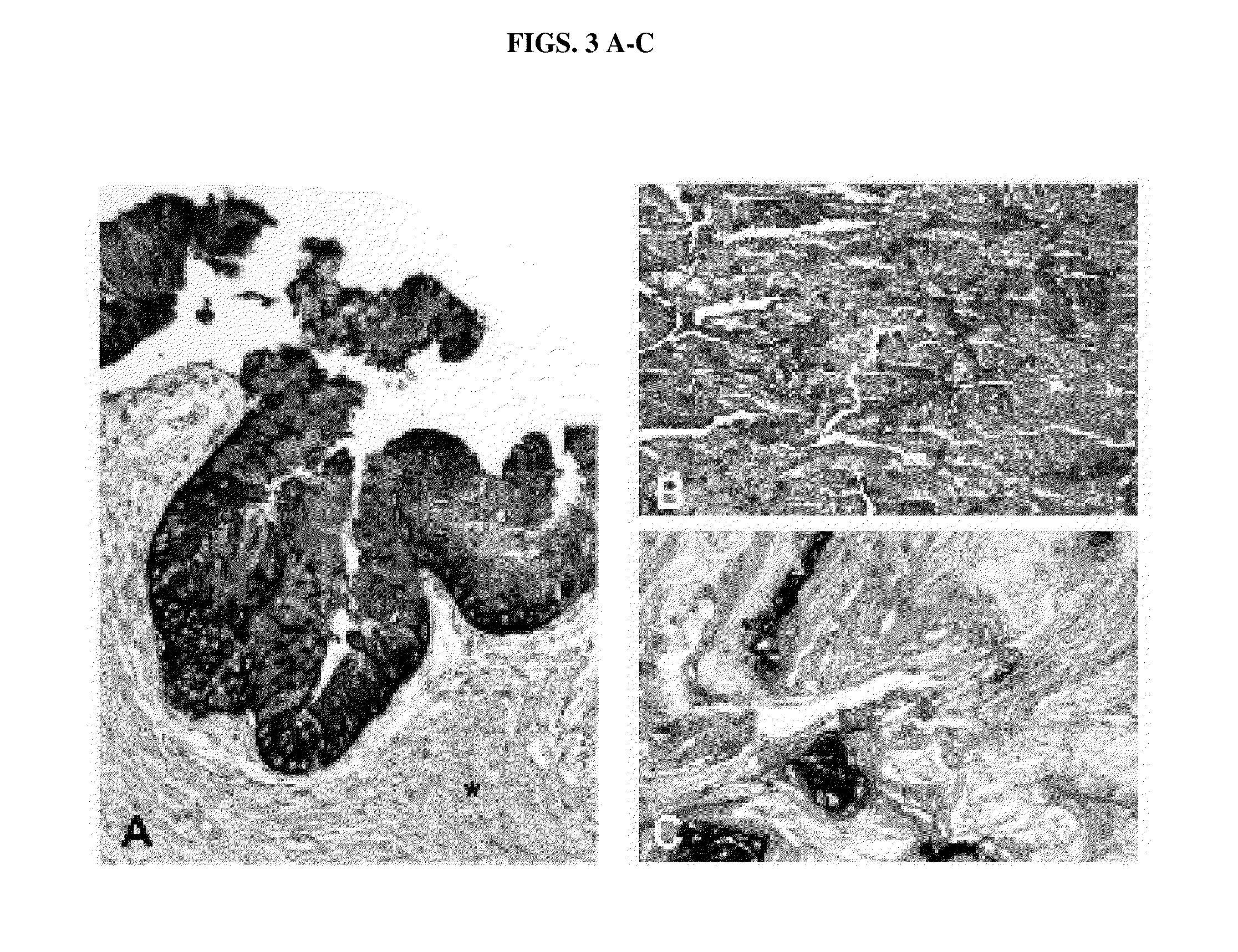Detection of high-risk intraductal papillary mucinous neoplasm and pancreatic adenocarcinoma
a high-risk, intra-ductal papillary mucinous neoplasm and pancreatic cancer technology, applied in the direction of instruments, biological material analysis, measurement devices, etc., can solve the problems of prone to invasive carcinoma and poor survival of invasive ipmn, and achieve the effect of reducing the risk of invasive carcinoma
- Summary
- Abstract
- Description
- Claims
- Application Information
AI Technical Summary
Benefits of technology
Problems solved by technology
Method used
Image
Examples
example 1
[0085]This example describes materials and methods used in EXAMPLES 2-4 below.
[0086]Study Subjects
[0087]The Massachusetts General Hospital institutional review board approved this study. A total of 271 patients with surgically resected, pathologically confirmed IPMN between January 1990 and December 2008 were identified from a prospectively collected database. Of those, 77 patients were randomly selected based on the availability of tissue blocks and in order to encompass main epithelial subtypes and all histologic grades. In this cohort, there were 108 distinct, non-invasive IPMN lesions and 11 invasive IPMNs: 26 lesions (from 25 patients) were included in a tissue microarray (TMA) that was previously prepared (see below) and 93 lesions (from 52 patients) with matched normal tissue were from whole tissue sections.
[0088]Pancreatic cyst fluid was collected from a completely separate cohort of 16 patients with benign and malignant pancreatic cysts. Fluid was aspirated peri-procedurall...
example 2
mAb Das-1 is Specific for High-Risk and Malignant IPMN Lesions
[0100]Of the 77 patients, 42 were male and age ranged 37-89 years (mean 68 years). The main pancreatic duct was involved by IPMN in 54 patients (10 main-duct type and 44 combined type) and the lesion was confined to branch ducts in 23. With regard to other clinicopathological features, there was no significant difference in Das-1 expression in age (p=0.446), gender (p=0.146) and type of duct involvement (branch-duct type vs. main-duct and combined type, p=0.087).
[0101]All normal pancreatic duct controls were negative for Das-1. Pancreatic parenchyma including IPMN associated pancreatitis (FIG. 1C) and stroma adjacent to IPMN lesions (FIG. 3A, starred) was also non-reactive in all the samples examined. When reactive to mAb Das-1, the lesional epithelium of IPMNs exhibited intense staining in cytoplasmic and / or membranous patterns, and no difference was observed in staining pattern, distribution, or results between tissue m...
example 3
Mab Das-1 is Significantly Over-Expressed in Pancreatic Cyst Fluid from High Grade Invasive IPMNT in Comparison to Low Grade Lesions
[0105]Pancreatic cyst fluid collected from low grade IPMN-G demonstrated very little reactivity to mAb Das-1 by sandwich ELISA assay (OD 0.088±0.003, n=2). In comparison, high grade IPMN lesions (moderate / high grade IPMN-G, IPMN-I, Heterogeneous IPMN with gastric and intestinal subtypes) expressed a significantly higher amount of reactivity (OD 0.824±0.167, n=7, p<0.005) (FIG. 4B). Examination of representative samples of cyst fluid by western blot analysis demonstrates a progressive increase in mAb Das-1 reactivity from low grade IPMN-G, high grade IPMN-G, and invasive IPMN-I lesions (FIG. 4A, Lanes 1, 2, 3 respectively). When examined by subtype, low grade IPMN-G (OD 0.088±0.003, n=2), moderate / high grade IPMN-G (OD 0.402±0.221, n=2), heterogeneous IPMN with gastric and intestinal subtypes (OD 0.915±0.0285, n=3), and IPMN-I (OD 1.109±0.158, n=2) demon...
PUM
 Login to View More
Login to View More Abstract
Description
Claims
Application Information
 Login to View More
Login to View More - R&D
- Intellectual Property
- Life Sciences
- Materials
- Tech Scout
- Unparalleled Data Quality
- Higher Quality Content
- 60% Fewer Hallucinations
Browse by: Latest US Patents, China's latest patents, Technical Efficacy Thesaurus, Application Domain, Technology Topic, Popular Technical Reports.
© 2025 PatSnap. All rights reserved.Legal|Privacy policy|Modern Slavery Act Transparency Statement|Sitemap|About US| Contact US: help@patsnap.com



